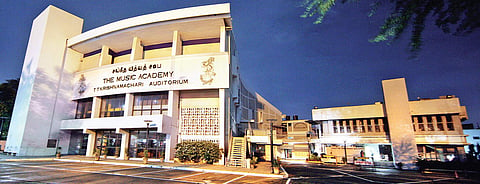A musical landmark for 91 years
CHENNAI: December 25 marked the 91st year of The Music Academy. And what better way to celebrate the occasion than to go on a heritage tour inside the institution that embodies everything Chennai celebrates about performing arts. Historian V Sriram took us on a 90 minute tour inside the premises to learn more about its history.
day in 1955
Ninety years ago on Christmas, the Congress party conducted its meeting and parallely provided music as entertainment. Spurtank was the location. Tents were raised for music concerts and the conferences were held in Museum Theatre till January 1. “Towards the end of the conference on Decemeber 28, KV Ramachandran, who ran Keshavardhini Hair Oil company, presented a paper on ‘The necessity for an academy for music in Madras’. Hence, with the surplus money they received during the event, they had formally inaugurated The Music Academy on August 18, 1928, at YMCA, opposite High Court,” he explained.
We walked into the mini hall that has the portrait of the first president of the academy. “Dr U Rama Rao was in office from 1928-34, and his house on Thambu Chetty Street was the office. He funded many endowment concerts that was conducted in his clinic, which turned into a hall (Gana Mandir) when he was not practicing. Citing his involvement in various other organisations and activities he stepped down,” added Sriram.
And then came a man who would be president for 30 years (1935-1965). The bust of Rao Bahadur KV Krishnaswamy Aiyar (KVK), near the VIP entrance, was the spot for our discussion. “KVK was known for his temper. He brought in rules and regulations that are followed till date. Some of them include, time keeping (for the artistes) and mandatory tickets for the audience members,” shared Sriram adding anecdote where KVK famously downed the curtains on Madurai Mani Iyer for overshooting his performance.
“Another one is with Alladi Krishnaswamy Iyer. He had attended and enjoyed the show without any ticket, and even the boy scouts were scared to ask him. When Alladi went home, he found a written note with an invoice from KVK asking him to pay the due sum for the ticket. That’s how strict he was,” he laughed.
KVK had Parkinsons Disease and died during the music festival in 1965 (December 21). “It was during Semmangudi Srinivasa Iyer’s programme, which was stopped midway. All the shows were cancelled the next day.”
The Music Academy building on TTK Road, came into existence in 1961-62. The foundation stone was laid by Jawaharlal Nehru in 1955, but the need for a space dawned on the committee members in early 1940s. “Till then, concerts were held in various locations, like a pandal behind Ripon Building or at Senate House. When the other sabhas, Rasika Ranjani Sabha and Tamil Isai Sangam had a land of their own, Basheer Ahmed Syed, judge, Madras High Court, urged the members to purchase a land for it,” said Sriram.
It was TT Krishnamachari, the then Finance Minister of the country, who was instrumental in getting the final sum required to demolish and construct this building. “He was in a meeting with industrialists in Coimbatore, where he made them all patrons of the academy and asked them to pay a donation. Most of them did not even see the sabha,” he smiled.
The stage in the auditorium is 2,400 sqft...it also has an enormous shutter on the rear. “When the auditorium was built, everyone thought that RS Manohar will do some live action with elephants. It was built for that reason. The stage is also built to withstand its weight,” he said.
On the stage’s left is the portrait of the trinity of music — Thyagarajar, Muthuswami Dikshitar and Shyama Shastri. “It was painted by B Rajam in 1942-43. The yazhi on Dikshitar’s veenai is facing downwards. This is the only painting where you’ll find this,” he shared. On the stage’s right is the logo of Music Academy which includes a Saraswathi. This was made by artist Syama of Kalki.
The canteen in the academy too has its own history. “In 1941, KVK promised that they will organise food and Ambi’s Cafe was the first caterer. Then came Appasamy Iyer, who used to give people grated coconut mixed with jaggery and people went gaga over it. Then it was taken over by ‘Kasi Halwa’ Krishnamoorthy, erstwhile cook of MS Subbulakshmi, who made kasi halwa a popular dessert. From then on, we have had many such caterers, and this is an important part of the festival,” shared Sriram.
The walk ended at the library, which treasures old carnatic books, catalogues, brochures and other items.
How the Sangita Kalanidhi is chosen
In 1929, a music festival was held in March and the management of the academy wanted one musician to spearhead the proceedings. Explains Sriram, “In 1934, rival sabhas came up; to maintain its stature, The Music Academy instituted the Sangita Kalanidhi Award. KVK decided that from then on, the president of the music festival will be conferred the Sangita Kalanidhi.”
Every year in July, the committee members meet and discuss the candidate for Sangita Kalanidhi. In August, the president of the academy calls the candidate and conveys the news.
Until December 14, they are called Sangita Kalanidhi elect. From Dec 15 to Jan 1, they are called Sangita Kalanidhi designate, and after that, Sangita Kalanidhi.

